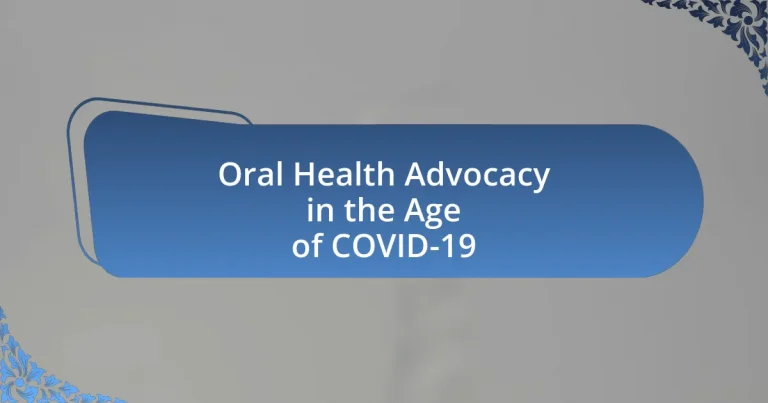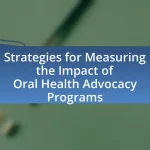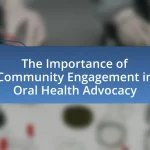Oral health advocacy during the COVID-19 pandemic has become increasingly vital as disruptions to dental services have led to heightened oral health issues. The article examines the impact of the pandemic on oral health advocacy, highlighting challenges faced by advocates, shifts in public perception, and the importance of maintaining access to dental care. It discusses strategies employed, such as telehealth and public awareness campaigns, and emphasizes the need for continued advocacy to address misinformation and promote preventive care. The article also explores future implications for oral health policies and the role of education in fostering community engagement and improving health outcomes.
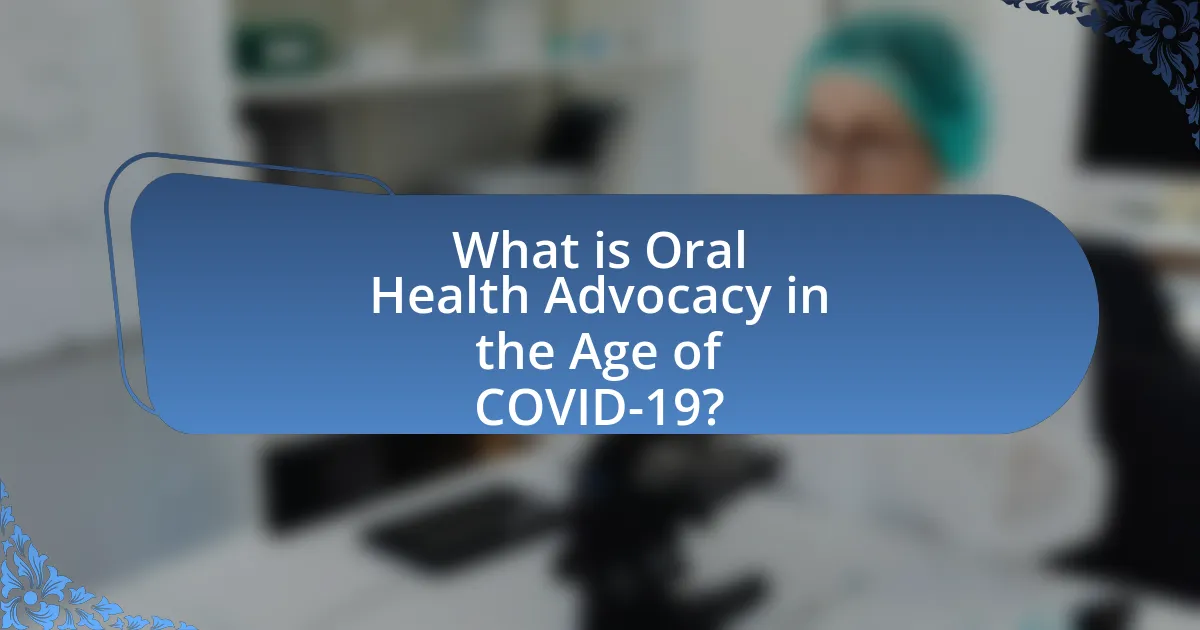
What is Oral Health Advocacy in the Age of COVID-19?
Oral health advocacy in the age of COVID-19 refers to efforts aimed at promoting and protecting oral health during the pandemic, emphasizing the importance of dental care amidst public health challenges. These advocacy initiatives have become crucial as the pandemic has disrupted routine dental services, leading to increased oral health issues due to delayed care and heightened anxiety about visiting healthcare facilities. Research indicates that oral health is closely linked to overall health, and neglecting dental care can exacerbate systemic health problems, making advocacy essential for raising awareness and ensuring access to necessary dental services during and after the pandemic.
How has the COVID-19 pandemic impacted oral health advocacy?
The COVID-19 pandemic has significantly heightened the focus on oral health advocacy by exposing the vulnerabilities in dental care access and public health systems. During the pandemic, many dental practices closed or limited services, leading to increased awareness of the importance of oral health as a component of overall health. Research published in the Journal of Dental Research indicates that oral diseases can exacerbate systemic health issues, reinforcing the need for integrated health advocacy. Additionally, the pandemic prompted organizations like the American Dental Association to advocate for policy changes that ensure better access to dental care and promote preventive measures, highlighting the critical role of oral health in public health strategies.
What specific challenges have arisen for oral health advocates during the pandemic?
Oral health advocates have faced significant challenges during the pandemic, primarily due to the disruption of dental services and increased public health concerns. The closure of dental practices and the postponement of non-emergency procedures led to a backlog of care, impacting access to essential oral health services. Additionally, advocates encountered difficulties in communicating the importance of oral health, as misinformation about COVID-19 and its effects on dental care proliferated. According to a survey by the American Dental Association, 76% of dental practices reported a decrease in patient volume, highlighting the urgent need for advocacy to address these access issues and promote safe dental practices during the pandemic.
How has public perception of oral health changed due to COVID-19?
Public perception of oral health has significantly shifted due to COVID-19, with increased awareness of its importance in overall health. The pandemic highlighted the connection between oral health and systemic diseases, leading to a greater emphasis on preventive care and hygiene practices. Surveys conducted during the pandemic indicated that many individuals began to prioritize dental visits and oral hygiene routines, recognizing their role in preventing infections. For instance, a study published in the Journal of Dental Research found that 70% of respondents reported increased concern about their oral health during the pandemic, reflecting a broader understanding of its implications for general health.
Why is oral health advocacy important during a pandemic?
Oral health advocacy is crucial during a pandemic because it ensures that individuals maintain access to essential dental care and information, which can prevent exacerbation of oral diseases. During COVID-19, many people delayed or avoided dental visits due to fear of infection, leading to increased oral health issues. Research indicates that untreated dental problems can contribute to systemic health complications, including respiratory infections, which are particularly concerning during a pandemic. Therefore, effective advocacy helps to promote safe dental practices, educate the public on the importance of oral health, and encourage timely dental care, ultimately supporting overall health during a public health crisis.
What role does oral health play in overall health during COVID-19?
Oral health significantly impacts overall health during COVID-19 by influencing systemic conditions and immune response. Poor oral hygiene can lead to periodontal disease, which has been linked to increased severity of respiratory infections, including COVID-19. Studies indicate that individuals with periodontal disease may experience worse outcomes due to the inflammatory response triggered by oral bacteria, which can exacerbate respiratory issues. Furthermore, maintaining good oral health can enhance immune function, making the body more resilient against infections.
How can oral health advocacy improve health outcomes in the context of COVID-19?
Oral health advocacy can improve health outcomes in the context of COVID-19 by promoting preventive care and reducing the risk of oral diseases that can complicate respiratory infections. Effective advocacy efforts can increase public awareness about the importance of maintaining oral hygiene, which is crucial as poor oral health has been linked to higher rates of respiratory infections, including COVID-19. Studies have shown that individuals with periodontal disease are at a greater risk for severe COVID-19 outcomes, highlighting the need for oral health education and access to dental care during the pandemic. By addressing these issues, oral health advocacy can lead to better overall health outcomes and potentially lower hospitalization rates related to COVID-19 complications.
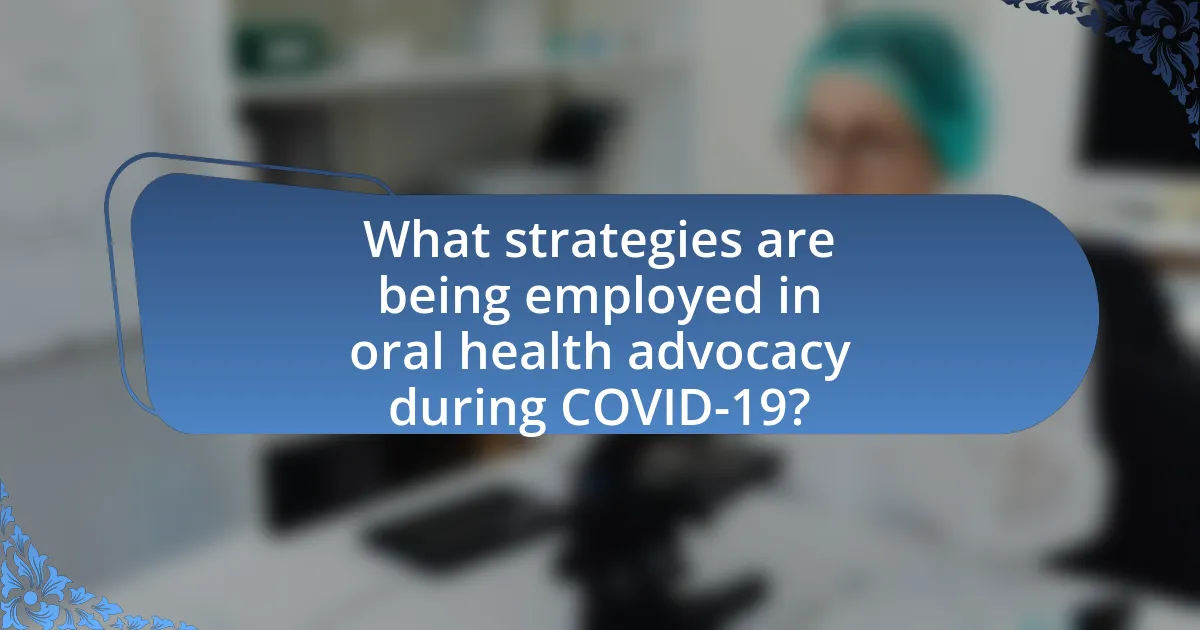
What strategies are being employed in oral health advocacy during COVID-19?
Oral health advocacy during COVID-19 employs strategies such as telehealth services, public awareness campaigns, and collaboration with health organizations. Telehealth services have enabled dental professionals to provide consultations and follow-up care remotely, ensuring patients receive necessary guidance while minimizing in-person visits. Public awareness campaigns focus on educating communities about the importance of maintaining oral hygiene during the pandemic, highlighting the link between oral health and overall health. Collaboration with health organizations, including the World Health Organization and local health departments, has facilitated the dissemination of accurate information and resources, reinforcing the significance of oral health in public health discussions during COVID-19.
How are organizations adapting their advocacy efforts in response to COVID-19?
Organizations are adapting their advocacy efforts in response to COVID-19 by shifting to digital platforms and focusing on telehealth initiatives. Many advocacy groups have increased their online presence through social media campaigns, webinars, and virtual meetings to engage stakeholders and raise awareness about oral health issues during the pandemic. For instance, the American Dental Association reported a significant rise in the use of telehealth services, which allowed dental professionals to provide consultations remotely, ensuring continued patient care while adhering to safety protocols. This transition not only maintains advocacy momentum but also addresses the challenges posed by in-person interactions during the health crisis.
What digital tools are being utilized for oral health advocacy?
Digital tools utilized for oral health advocacy include social media platforms, mobile applications, and telehealth services. Social media platforms like Facebook and Instagram facilitate the dissemination of oral health information and community engagement, allowing organizations to reach a broader audience. Mobile applications provide users with resources for oral hygiene education and appointment reminders, enhancing personal health management. Telehealth services enable remote consultations, making dental care more accessible during the COVID-19 pandemic, as evidenced by a significant increase in telehealth usage reported by the American Dental Association, which noted a 76% rise in virtual visits in 2020.
How are partnerships being formed to enhance advocacy efforts?
Partnerships are being formed to enhance advocacy efforts through collaborative initiatives among healthcare organizations, community groups, and policymakers. These partnerships leverage shared resources and expertise to address oral health disparities exacerbated by the COVID-19 pandemic. For instance, organizations like the American Dental Association have partnered with public health agencies to promote telehealth services, ensuring access to dental care during lockdowns. Additionally, community outreach programs have been established to educate vulnerable populations about oral health, demonstrating the effectiveness of joint efforts in advocacy.
What messages are being communicated to the public regarding oral health?
Public health campaigns are communicating that maintaining good oral health is essential for overall health, especially during the COVID-19 pandemic. These messages emphasize the importance of regular dental check-ups, proper oral hygiene practices, and the connection between oral health and systemic diseases, such as diabetes and heart disease. For instance, the Centers for Disease Control and Prevention (CDC) highlights that poor oral health can lead to serious health complications, reinforcing the need for preventive care. Additionally, organizations like the American Dental Association (ADA) stress that oral health should not be neglected during the pandemic, as it plays a critical role in overall well-being and can impact the immune system.
How are health professionals addressing misinformation about oral health during the pandemic?
Health professionals are addressing misinformation about oral health during the pandemic by utilizing digital platforms to disseminate accurate information and engage with the public. They are creating educational content, such as videos and articles, that clarify misconceptions about oral health practices, particularly regarding the safety of dental visits and the importance of maintaining oral hygiene during COVID-19. For instance, the American Dental Association has launched campaigns that provide evidence-based guidelines and resources to counter false claims circulating on social media. This proactive approach helps ensure that the public receives reliable information, thereby reducing anxiety and promoting better oral health practices during the pandemic.
What campaigns have been launched to promote oral health awareness during COVID-19?
Several campaigns have been launched to promote oral health awareness during COVID-19, including the “Brush Up on Oral Health” initiative by the American Dental Association (ADA) and the “Oral Health for All” campaign by the World Health Organization (WHO). The ADA’s campaign focused on educating the public about maintaining oral hygiene during the pandemic, emphasizing the importance of regular brushing and dental check-ups despite restrictions. The WHO’s campaign aimed to raise awareness about the link between oral health and overall health, particularly in the context of COVID-19, highlighting that poor oral health can increase the risk of severe complications from the virus. These campaigns utilized social media, webinars, and community outreach to effectively disseminate information and engage the public.
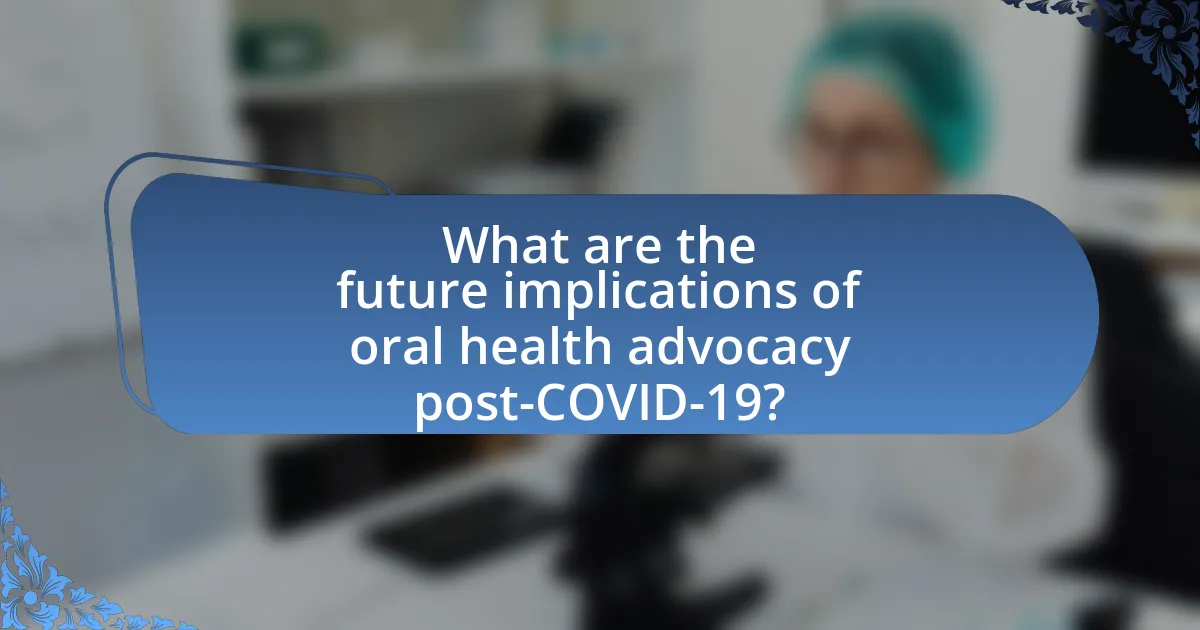
What are the future implications of oral health advocacy post-COVID-19?
The future implications of oral health advocacy post-COVID-19 include an increased emphasis on preventive care and the integration of telehealth services. As the pandemic highlighted the importance of maintaining oral health to prevent systemic diseases, advocacy efforts will likely focus on educating the public about the links between oral health and overall health. Additionally, the rise of telehealth during the pandemic has shown that remote consultations can effectively address oral health issues, leading to a potential permanent shift in how dental care is delivered. According to a study published in the Journal of Dental Research, telehealth services increased by over 150% during the pandemic, indicating a significant change in patient engagement and access to care. This shift suggests that future oral health advocacy will prioritize accessibility and preventive measures, ultimately aiming to improve health outcomes in the population.
How might the lessons learned during the pandemic shape future oral health advocacy?
The lessons learned during the pandemic will significantly shape future oral health advocacy by emphasizing the importance of telehealth and preventive care. Telehealth services expanded rapidly during the pandemic, demonstrating their effectiveness in providing access to dental care, especially for underserved populations. According to a study published in the Journal of the American Dental Association, telehealth consultations increased by over 200% during the pandemic, highlighting a shift towards remote care that can continue to enhance access in the future. Additionally, the pandemic underscored the critical role of preventive measures, such as oral hygiene education and community outreach, in maintaining oral health during public health crises. This focus on prevention can lead to more robust advocacy efforts aimed at integrating oral health into overall health policies, ensuring that oral health remains a priority in future health initiatives.
What long-term changes can be expected in oral health policies?
Long-term changes in oral health policies are expected to focus on increased integration of oral health into overall health care systems. This shift is driven by the recognition of the connection between oral health and systemic health, as evidenced by studies linking periodontal disease to conditions such as diabetes and cardiovascular disease. Additionally, policies are likely to emphasize preventive care and access to dental services, particularly for underserved populations, as highlighted by the American Dental Association’s initiatives to improve health equity. Furthermore, the COVID-19 pandemic has accelerated the adoption of telehealth services in dentistry, which may become a permanent feature of oral health care delivery, enhancing access and convenience for patients.
How can advocates ensure sustained focus on oral health in future health crises?
Advocates can ensure sustained focus on oral health in future health crises by integrating oral health into broader public health strategies and policies. This integration can be achieved through collaboration with health organizations, policymakers, and community leaders to emphasize the importance of oral health in overall health outcomes. For instance, during the COVID-19 pandemic, studies indicated that individuals with poor oral health had a higher risk of severe complications, highlighting the need for oral health to be prioritized in health crisis responses. By utilizing data and research that demonstrate the link between oral health and systemic health, advocates can effectively argue for the inclusion of oral health initiatives in emergency preparedness plans.
What best practices can be adopted for effective oral health advocacy moving forward?
Effective oral health advocacy moving forward can be achieved by utilizing a multi-faceted approach that includes community engagement, policy advocacy, and leveraging technology. Community engagement fosters awareness and education about oral health issues, as evidenced by initiatives like the American Dental Association’s “Give Kids A Smile” program, which has provided free dental care to over 5 million children since its inception. Policy advocacy is crucial for influencing legislation that supports oral health access, demonstrated by the successful expansion of Medicaid dental benefits in several states, which has improved access for low-income populations. Additionally, leveraging technology, such as telehealth services, has proven effective during the COVID-19 pandemic, allowing dental professionals to reach patients remotely and maintain continuity of care. These best practices collectively enhance the effectiveness of oral health advocacy efforts.
How can advocates engage communities to promote oral health awareness?
Advocates can engage communities to promote oral health awareness by organizing educational workshops and outreach programs that focus on the importance of oral hygiene. These initiatives can include free dental check-ups, distribution of oral health materials, and interactive sessions that address common misconceptions about dental care. Research indicates that community-based interventions significantly improve health knowledge; for instance, a study published in the Journal of Public Health Dentistry found that educational programs led to a 30% increase in oral health knowledge among participants. By leveraging local partnerships with schools, health organizations, and community leaders, advocates can effectively reach diverse populations and foster a culture of proactive oral health practices.
What role does education play in future oral health advocacy efforts?
Education plays a crucial role in future oral health advocacy efforts by equipping individuals with the knowledge necessary to make informed decisions about their oral health. This foundational understanding fosters awareness of preventive measures, treatment options, and the importance of regular dental visits, which are essential for maintaining oral hygiene and overall health. Research indicates that communities with higher levels of oral health education experience lower rates of dental diseases, highlighting the effectiveness of educational initiatives in promoting better health outcomes. For instance, a study published in the Journal of Dental Research found that educational programs significantly improved oral health literacy among participants, leading to increased utilization of dental services. Thus, education serves as a vital tool in empowering individuals and communities to advocate for their oral health needs effectively.
